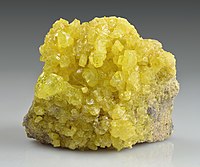
Photo from wikipedia
Yeast extract (YE) is tremendously used as a flavor enhancer in foods because of its composition. However, different types of YE have different aromatic profiles. This study focuses on the… Click to show full abstract
Yeast extract (YE) is tremendously used as a flavor enhancer in foods because of its composition. However, different types of YE have different aromatic profiles. This study focuses on the thermal treatment of glutathione-enriched yeast extract (GSH-YE) at different temperatures with the addition of Maillard precursors to investigate any change in its volatile organic profile. Headspace gas chromatography-ion mobility spectrometry (HS-GC-IMS) was utilized for the instrumental analysis. A total number of 104 volatile compounds were analyzed through this approach. Qualitative and quantitative analysis of the samples were made in order to calculate the concentration of volatile compounds in samples. Sensory evaluation was performed to compare the overall aroma descriptions with the volatile profile of the heat-treated samples. Sensory scores revealed that an increase in the thermal temperature significantly affected the meaty and roasted aroma of GSH-YE. Many sulfur-containing volatile compounds including 2-methyl-3-furanthiol, 2-furfurylthiol, 2-methyl-3-(methylthio)furan, dimethyl trisulfide, 2-acetylthiazol, and some furans and pyrazines related to meaty and roasted odor notes were reported in this study. Significant increase in the amounts of furfural and dimethyl sulfide was observed in samples having higher thermal temperatures as compared with the control treatment. The temperature of 100 °C with adequate amounts of Maillard precursors in GSH-YE was considered an optimal condition for generating ample amounts of 2-methyl-3-methylthiofuran and 2-furfurylthiol. The 3D graphical data confirms the potential application of HS-GC-IMS as a more potent instrumental approach in the determination of volatile compounds in yeast extract. An over view of volatile classification in heat-treated glutathione-enriched yeast extract via GC-IMS technique. A total number of 104 volatile organic compounds were identified through this approach. The concentration of sulfur-containing volatile compounds was significantly changed in three samples. An over view of volatile classification in heat-treated glutathione-enriched yeast extract via GC-IMS technique. A total number of 104 volatile organic compounds were identified through this approach. The concentration of sulfur-containing volatile compounds was significantly changed in three samples.
Journal Title: Food Analytical Methods
Year Published: 2020
Link to full text (if available)
Share on Social Media: Sign Up to like & get
recommendations!